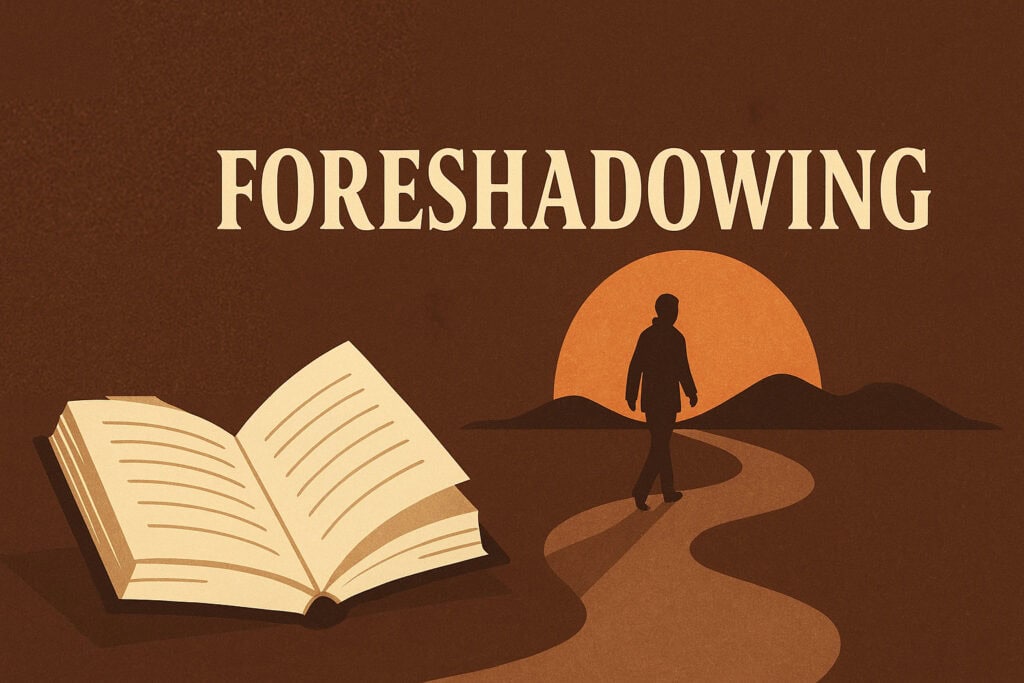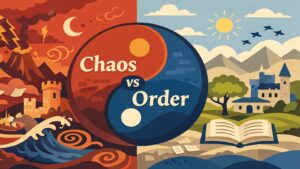Table of Contents
Introduction: How Foreshadowing Primes the Emotional Landscape
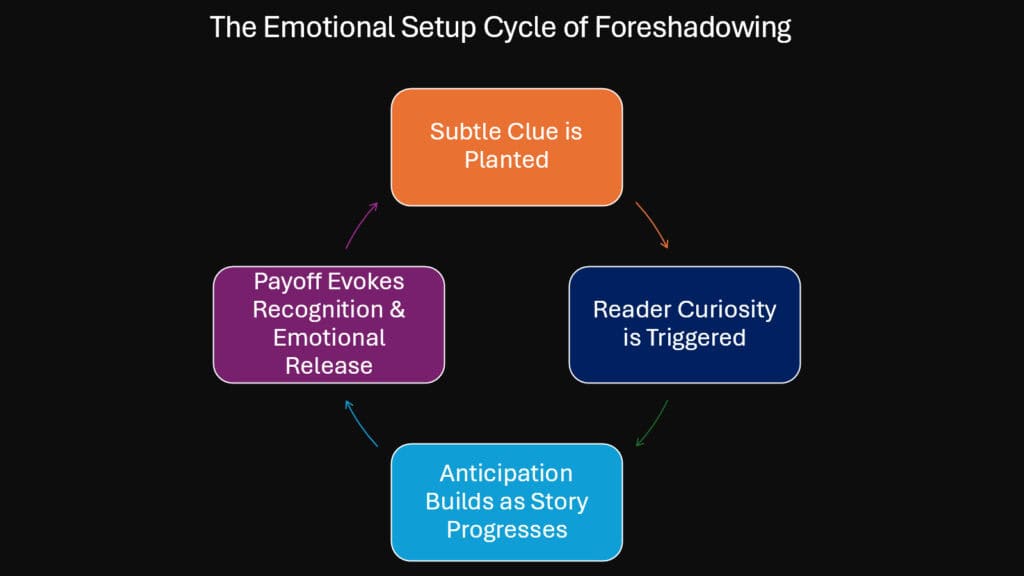
The storyteller’s greatest magic lies not in revealing secrets, but in whispering promises of what’s to come. Foreshadowing stands as one of literature’s most powerful and widely used storytelling techniques, threading through narratives like veins of gold through stone. When Sophocles warned his audience through the Oracle’s prophecy that Oedipus would kill his father and marry his mother, he wasn’t simply sharing plot points. He was crafting an emotional architecture that would support the weight of tragedy yet to unfold.
Foreshadowing operates as literature’s emotional primer, establishing a subtle contract between writer and reader. This contract doesn’t guarantee specific outcomes but promises that every shadow cast will eventually find its light. Through carefully planted seeds of suggestion, authors guide readers into states of anticipation, curiosity, and trust that transform how we experience stories. The technique transcends mere plot convenience, becoming a psychological instrument that tunes our emotional responses to narrative rhythms.
From the storm clouds gathering in Emily Brontë’s “Wuthering Heights” to the recurring motif of cherry blossoms in Yasunari Kawabata’s “Snow Country,” foreshadowing creates emotional resonance that echoes long after the final page. Whether subtle as Gabriel García Márquez’s butterflies preceding death in “One Hundred Years of Solitude” or bold as the witches’ prophecies in Shakespeare’s “Macbeth,” these literary breadcrumbs shape how we feel about characters and events before they fully manifest.
This exploration examines six distinct ways foreshadowing manipulates reader emotion, from building tension through dramatic structure to creating misdirection that leaves us emotionally blindsided. Each method reveals how skilled authors don’t just tell stories—they orchestrate emotional experiences that linger in memory like half-remembered dreams.
Table 1: Emotional Functions of Foreshadowing Across Cultures
| Literary Tradition | Common Techniques To Foreshadow | Primary Emotional Effect |
|---|---|---|
| Western Classical | Prophecies, omens, divine warnings | Tragic inevitability |
| East Asian | Seasonal imagery, natural cycles | Melancholic acceptance |
| African Oral | Animal symbolism, ancestral dreams | Spiritual anticipation |
| Latin American | Magical realism, cyclical time | Mystical unease |
| India | Karma concepts, ritual significance | Moral tension |
| Indigenous Australian | Dreamtime references, land connections | Ancestral foreboding |
1. Foreshadowing and the Tension Arc: Stretching the Emotional Thread
Freytag’s Pyramid reveals how foreshadowing intensifies the rising action of dramatic structure, creating emotional unease that builds toward climactic release. This technique doesn’t simply announce future events—it stretches the emotional thread connecting setup to payoff, making readers active participants in their own emotional manipulation. The longer this thread extends, the more profound the eventual snap of resolution becomes.
Consider how Chinua Achebe employs this technique in “Things Fall Apart,” where early descriptions of Okonkwo’s violent temper and rigid adherence to masculine ideals foreshadow his tragic downfall. Achebe doesn’t reveal the specific nature of Okonkwo’s destruction, but each display of his inflexibility adds tension to the emotional thread. Readers sense impending doom without knowing its exact form, creating a sustained anxiety that permeates the entire narrative.
Japanese literature offers another compelling example through Yukio Mishima’s “The Sea of Fertility” tetralogy, where dreams of death and reincarnation create an emotional undercurrent throughout four separate novels. The foreshadowing operates across decades of narrative time, with each incarnation of the protagonist carrying forward the emotional weight of previous deaths. This extended tension arc demonstrates how foreshadowing can operate on massive scales, creating emotional architectures that span entire literary universes.
The genius of tension-building foreshadowing lies in its ability to make readers complicit in their own emotional manipulation. We see the signs, recognize the patterns, yet remain powerless to prevent the inevitable. This creates a unique form of dramatic irony where our knowledge becomes a burden rather than empowerment. The emotional thread stretches tighter with each passing chapter, until the final revelation provides both release and retrospective understanding of every subtle hint that preceded it.
Table 2: Freytag’s Pyramid and Foreshadowing Integration
| Dramatic Stage | Foreshadowing Function | Emotional Impact | Literary Example |
|---|---|---|---|
| Exposition | Establish emotional tone | Curiosity, unease | Brontë’s stormy weather |
| Rising Action | Build anticipation | Growing tension | Achebe’s character flaws |
| Climax | Fulfill promises | Cathartic release | Sophocles’ prophecy completion |
| Falling Action | Reveal connections | Recognition, understanding | Faulkner’s timeline revelations |
| Resolution | Provide closure | Satisfaction, melancholy | García Márquez’s cyclical endings |
2. Foreshadowing as Emotional Irony: When the Reader Knows Before the Character
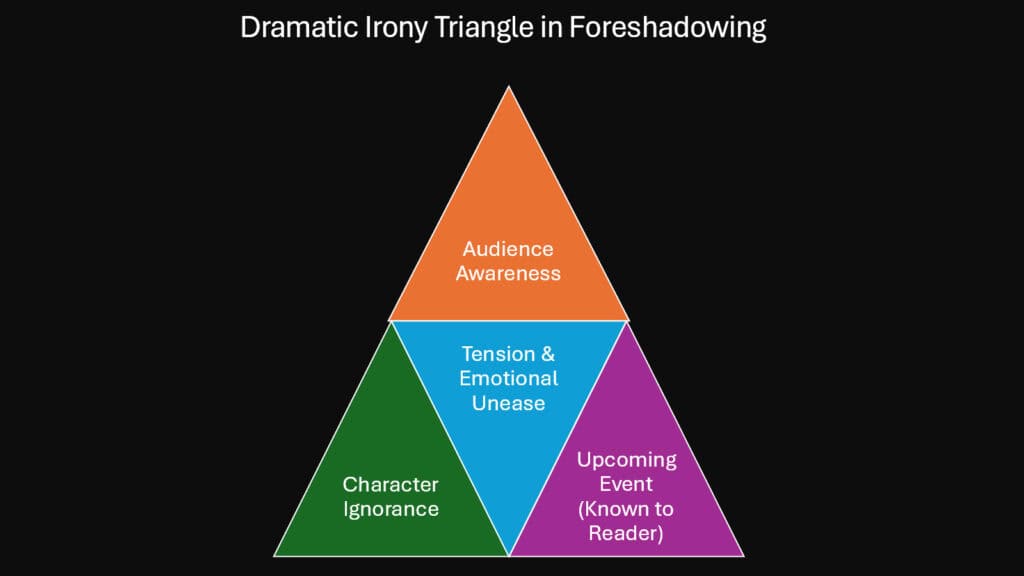
Dramatic irony through foreshadowing creates one of literature’s most emotionally complex relationships between reader and character. When authors share knowledge with readers that remains hidden from protagonists, they transform us into helpless witnesses to unfolding tragedy or triumph. This technique generates emotions ranging from protective anxiety to frustrated helplessness, as we watch characters stumble toward fates we can clearly see approaching.
Toni Morrison masterfully employs this technique in “Beloved,” where the recurring image of a red heart painted on a tree trunk foreshadows the revelation of infanticide at the novel’s emotional core. Readers gradually piece together the horrific truth while Sethe herself remains locked in psychological denial. This creates an almost unbearable tension as we understand the source of the supernatural haunting before the characters fully acknowledge their trauma. The emotional weight of knowing becomes a shared burden between Morrison and her readers.
Similarly, in R.K. Narayan’s “The Guide,” early references to Raju’s tendency toward deception and his fascination with holy men foreshadow his eventual transformation from con artist to reluctant saint. Narayan enables readers to identify the patterns in Raju’s behavior, even as the character himself is oblivious to his own spiritual path. This creates a poignant irony where readers watch a man become what he initially only pretended to be, understanding the transformation’s significance before he does.
The emotional power of this technique lies in its creation of intimate reader relationships with characters who cannot reciprocate our knowledge. We become emotional guardians, protective observers who want to warn heroes or heroines of the stories about approaching dangers or encourage them toward hidden opportunities. This one-sided intimacy generates profound empathy, as we experience both the character’s ignorance and our own powerlessness to intervene in their fictional fates.
Table 3: Dramatic Irony Through Foreshadowing
| Author | Work | Foreshadowed Event | Reader Knowledge | Character Blindness |
|---|---|---|---|---|
| Morrison | Beloved | Infanticide revelation | Gradual understanding | Psychological denial |
| Narayan | The Guide | Spiritual transformation | Pattern recognition | Self-deception |
| Sophocles | Oedipus Rex | Patricide and incest | Prophetic certainty | Prideful ignorance |
| Hardy | Tess of the d’Urbervilles | Tragic fate | Social inevitability | Naive optimism |
| Dostoevsky | Crime and Punishment | Confession necessity | Moral logic | Rationalization |
3. Foreshadowing and Reader-Response Theory: Shaping Feelings Through Interpretation
Reader-Response Theory illuminates how foreshadowing invites readers to co-create meaning, transforming subtle hints into vessels for personal emotion, memory, and expectation. This collaborative process makes each reader’s emotional journey unique, as individual experiences and cultural backgrounds shape how foreshadowing elements are interpreted and felt. The same symbolic image might evoke entirely different emotional responses depending on who encounters it.
Isabel Allende demonstrates this principle beautifully in “The House of the Spirits,” where recurring references to green hair and supernatural abilities allow readers to project their own understanding of magic and femininity onto the narrative. Some readers might interpret Clara’s prescient abilities as genuine supernatural gifts, while others see them as metaphors for feminine intuition or artistic sensitivity. This interpretive flexibility makes each reader’s emotional investment personal and unique.
Korean author Park Kyung-ni employs similar techniques in “The Land,” where references to changing seasons and agricultural cycles foreshadow political and social transformations. Readers from agricultural backgrounds might feel deeper emotional connections to these natural metaphors, while urban readers might interpret them more abstractly. The foreshadowing works regardless of interpretation, but the emotional resonance varies based on individual reader experiences and cultural contexts.
This collaborative meaning-making process transforms foreshadowing from simple literary technique into emotional dialogue between author and reader. Writers provide the raw materials—images, symbols, subtle references—while readers supply the emotional and experiential context that gives these elements power. The result is a reading experience that feels simultaneously universal and deeply personal, as each reader’s unique perspective shapes how foreshadowing elements develop emotional significance.
Table 4: Reader-Response Variables in Foreshadowing Interpretation
| Reader Factor | Influence on Interpretation | Emotional Impact | Example |
|---|---|---|---|
| Cultural Background | Symbolic meaning variation | Deep/surface resonance | Allende’s supernatural elements |
| Personal Experience | Metaphor recognition | Intimate/distant connection | Park’s agricultural imagery |
| Literary Knowledge | Pattern awareness | Anticipatory/surprised reaction | Classical allusion recognition |
| Emotional State | Receptivity to themes | Heightened/muted response | Mood-dependent symbolism |
| Age and Life Stage | Relevance perception | Relevant/abstract meaning | Generational theme recognition |
4. Foreshadowing and Nostalgia: When Payoffs Echo Like Emotional Flashbacks
Emotional resonance reaches its peak when earlier foreshadowing hints resurface during climactic moments, creating waves of recognition that feel like emotional flashbacks. This technique transforms readers into time travelers, simultaneously experiencing present narrative developments while remembering past subtle clues. The collision between memory and revelation generates a unique form of literary nostalgia that deepens emotional impact exponentially.
Marcel Proust’s “In Search of Lost Time” exemplifies this technique through its famous madeleine episode, where the taste of a small cake triggers cascading memories that span thousands of pages. The initial sensory experience serves as foreshadowing for the vast emotional landscape that follows, while later references to taste and memory create recurring waves of nostalgic recognition. Each return to these themes carries the accumulated weight of everything that came before.
Australian author Patrick White employs similar techniques in “Voss,” where early descriptions of the explorer’s spiritual arrogance foreshadow his desert transformation. When Voss finally confronts his mortality in the wasteland, readers experience dual emotions—the immediate dramatic tension of survival and the nostalgic recognition of character patterns established hundreds of pages earlier. This temporal layering creates emotional complexity that single-moment revelations cannot achieve.
The power of nostalgic foreshadowing lies in its ability to make readers feel simultaneously present and past, creating emotional time loops that deepen with each encounter. When symbolic elements return, they carry not just their immediate narrative significance but the accumulated emotional weight of every previous appearance. This creates a reading experience that feels archaeologically layered, with each revelation uncovering previously buried emotional artifacts.
Table 5: Nostalgic Foreshadowing Patterns
| Technique | Emotional Mechanism | Temporal Effect | Literary Example |
|---|---|---|---|
| Recurring Imagery | Symbol accumulation | Deepening resonance | Proust’s sensory triggers |
| Character Callbacks | Trait recognition | Inevitable confirmation | White’s spiritual patterns |
| Seasonal Cycles | Natural rhythm | Cyclical emotions | Kawabata’s seasonal returns |
| Musical Motifs | Rhythmic repetition | Harmonic building | Mann’s leitmotif usage |
| Color Symbolism | Visual accumulation | Intensifying association | Morrison’s recurring hues |
5. Foreshadowing Through Structuralism: Pattern, Expectation, and Emotional Logic
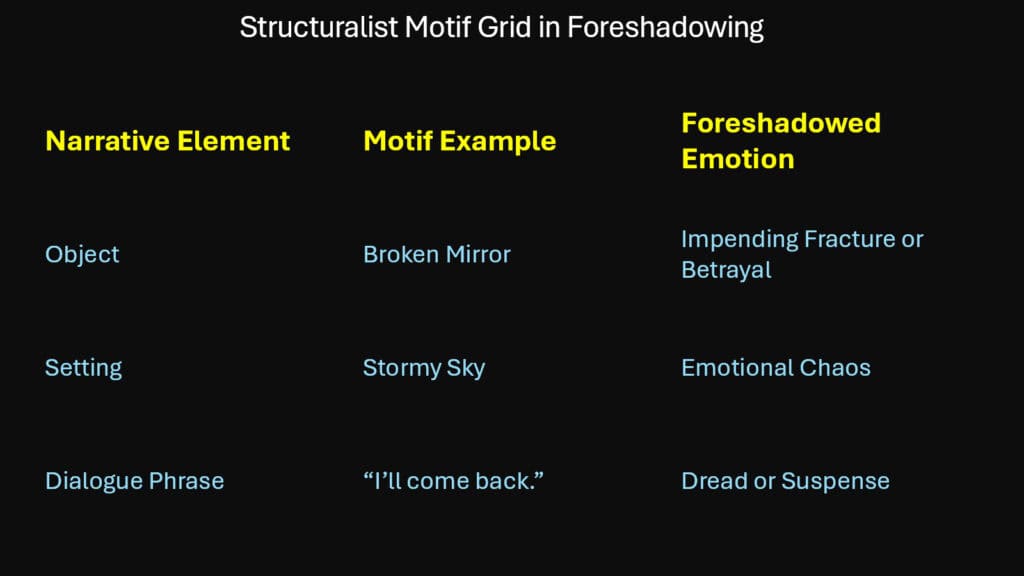
Structuralist analysis reveals how foreshadowing operates through narrative patterns that create emotional logic systems within stories. These patterns establish reader expectations not through explicit promises but through the recognition of underlying structural relationships. When authors establish consistent symbolic or thematic patterns, readers unconsciously develop emotional frameworks for interpreting subsequent narrative elements.
Jorge Luis Borges demonstrates this principle in his labyrinthine short stories, where recurring motifs of mirrors, libraries, and infinite recursion create structural patterns that foreshadow philosophical revelations. In “The Library of Babel,” early descriptions of hexagonal rooms and infinite book combinations establish a mathematical logic that emotionally prepares readers for the story’s meditation on knowledge and meaninglessness. The structural pattern creates its own emotional momentum independent of character development or plot progression.
Chinese author Mo Yan employs similar structural techniques in “Red Sorghum,” where patterns of violence, fertility, and historical repetition create emotional frameworks for understanding generational trauma. The recurring imagery of blood-red sorghum fields establishes a visual and emotional pattern that helps readers process the novel’s complex treatment of war, family, and cultural memory. Each return to this imagery carries forward the accumulated emotional weight of previous appearances.
Structuralist foreshadowing works by training readers to recognize emotional patterns rather than specific plot points. Once these patterns are established, even subtle variations create powerful emotional responses as readers sense disruptions in the established logical framework. This creates a form of emotional architecture where the structure itself becomes a character in the narrative, generating its own emotional momentum and significance.
Table 6: Structural Patterns in Foreshadowing
| Pattern Type | Structural Function | Emotional Logic | Cultural Example |
|---|---|---|---|
| Numerical Repetition | Mathematical rhythm | Ordered inevitability | Borges’ infinite series |
| Color Symbolism | Visual consistency | Associative emotion | Mo Yan’s red imagery |
| Geometric Forms | Spatial organization | Architectural feeling | Kafka’s maze structures |
| Musical Structure | Rhythmic progression | Harmonic anticipation | Joyce’s musical chapters |
| Seasonal Cycles | Temporal patterns | Natural emotional flow | Mishima’s seasonal deaths |
| Religious Symbolism | Spiritual framework | Sacred/profane tension | Dostoevsky’s Christian imagery |
6. Foreshadowing and Emotional Misdirection: Twisting the Knife With Broken Promises
Foreshadowing sometimes operates through deliberate deception, leading readers toward false expectations before subverting them to create emotional shock, betrayal, or collapse. This technique requires authors to establish seemingly reliable patterns before breaking them at crucial moments, transforming reader investment into emotional vulnerability. The deeper the initial investment, the more profound the eventual emotional disruption becomes.
Agatha Christie pioneered this technique in detective fiction, particularly in “The Murder of Roger Ackroyd,” where the narrator’s reliable perspective becomes the story’s greatest deception. Christie establishes Dr. Sheppard as a trustworthy observer through consistent narrative patterns, then reveals him as the murderer in a revelation that retroactively transforms every previous scene. The emotional impact comes not just from solving the mystery but from recognizing how thoroughly readers were manipulated by false foreshadowing.
Nigerian author Chimamanda Ngozi Adichie employs similar misdirection in “Half of a Yellow Sun,” where early descriptions of domestic tranquility and intellectual discourse foreshadow cultural sophistication rather than the brutal civil war that ultimately consumes these educated characters. The contrast between foreshadowed expectations and brutal reality creates emotional whiplash that mirrors the historical trauma of the Biafran conflict itself.
Emotional misdirection through foreshadowing requires authors to exploit reader trust, establishing reliable narrative contracts before deliberately violating them. This creates a unique form of literary betrayal where readers feel personally deceived by authors they trusted to play fair. The emotional complexity of this betrayal—simultaneously admiring the author’s skill while feeling manipulated—creates lasting emotional impressions that extend far beyond the immediate reading experience.
Table 7: Techniques of Emotional Misdirection
| Misdirection Method | Setup Strategy | Payoff Shock | Emotional Result |
|---|---|---|---|
| Unreliable Narrator | False reliability | Identity revelation | Betrayal, admiration |
| Genre Subversion | Expected patterns | Category violation | Disorientation, surprise |
| Character Reversal | Established traits | Personality inversion | Confusion, reappraisal |
| Temporal Tricks | Linear assumption | Timeline revelation | Temporal vertigo |
| Symbolic Reversal | Consistent meaning | Symbol inversion | Interpretive collapse |
| Cultural Expectations | Familiar frameworks | Cross-cultural shock | Perspective disruption |
Conclusion: Why Foreshadowing Leaves an Emotional Afterglow in Storytelling
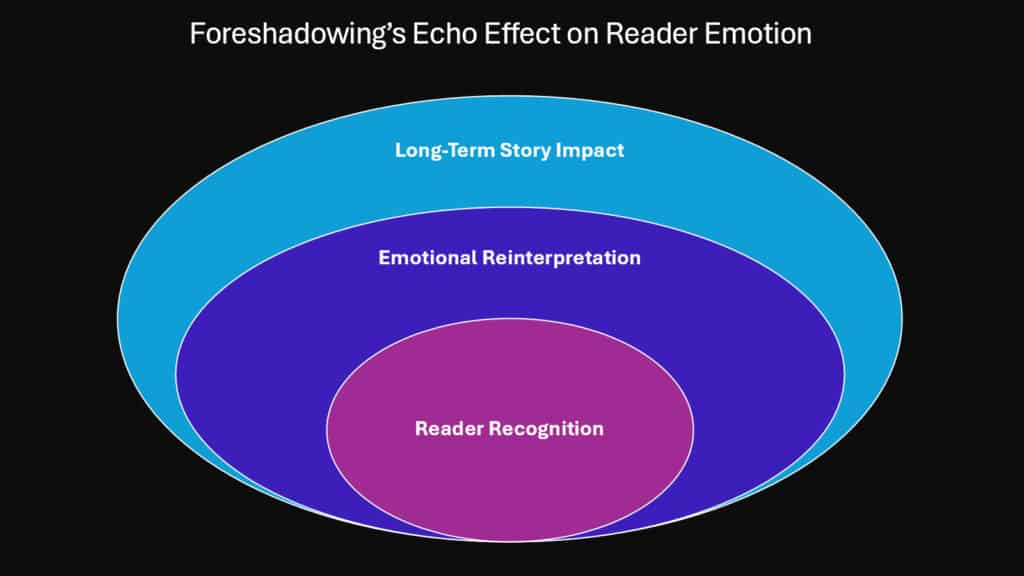
Foreshadowing transcends mere plot mechanics to become literature’s most sophisticated emotional technology. Through the six methods explored—tension building, dramatic irony, reader collaboration, nostalgic resonance, structural patterning, and emotional misdirection—authors create lasting emotional experiences that continue resonating long after stories end. These techniques don’t simply hint at future events; they create emotional architectures that support the full weight of human experience translated into narrative form.
The enduring power of foreshadowing lies in its ability to make readers active participants in their own emotional manipulation. We become co-conspirators in our own literary seduction, recognizing patterns while remaining helpless to resist their emotional pull. This willing vulnerability creates intimate relationships between readers and texts that transcend simple entertainment, becoming shared emotional experiences that shape how we understand storytelling itself.
From Sophocles’ ancient prophecies to contemporary authors like Haruki Murakami, who weaves surreal foreshadowing through novels like “Kafka on the Shore,” the technique continues evolving while maintaining its fundamental emotional power. Each generation of writers discovers new ways to plant seeds of anticipation that bloom into emotional revelation, proving that foreshadowing remains as relevant to modern storytelling as it was to ancient oral traditions.
The emotional afterglow of effective foreshadowing creates what we might call narrative memory—the lingering sense that stories continue existing in our consciousness long after we’ve finished reading them. This psychological persistence explains why certain books feel alive in memory while others fade immediately. Stories with masterful foreshadowing create emotional echoes that continue reverberating through our personal experiences, making literature genuinely transformative rather than merely entertaining.
Perhaps the greatest testament to foreshadowing’s emotional power is how it trains us to read our own lives differently. After experiencing how authors plant subtle clues that later bloom into major revelations, we begin noticing similar patterns in our personal narratives. We become more attuned to life’s subtle signals, more aware of how present moments might be foreshadowing future developments we cannot yet imagine.
Table 8: Lasting Effects of Foreshadowing on Readers
| Effect Category | Immediate Impact | Long-term Influence | Personal Application |
|---|---|---|---|
| Emotional Memory | Story resonance | Nostalgic recall | Life pattern recognition |
| Reading Skills | Pattern awareness | Literary sophistication | Critical thinking development |
| Empathy Development | Character connection | Emotional intelligence | Human understanding |
| Temporal Awareness | Narrative time | Historical consciousness | Personal timeline awareness |
| Symbolic Thinking | Metaphor recognition | Abstract reasoning | Meaning-making ability |
| Anticipatory Skill | Plot prediction | Life preparation | Future orientation |

